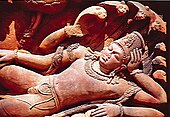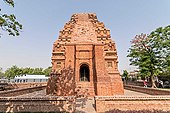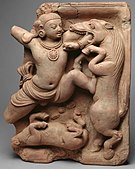Gupta Empire
Gupta Empire | |
|---|---|
| c. 240–c. 579[1] | |
Map of the Gupta Empire c. 420 CE, according to Joseph E. Schwartzberg, with contemporary polities[2] | |
| Status | Empire |
| Capital | |
| Common languages | Sanskrit (literary and academic); Prakrit (vernacular) |
| Religion | |
| Demonym(s) | Indian |
| Government | Monarchy |
| Maharajadhiraja[a] | |
• c. 240 – c. 280 | Gupta (first) |
• c. 540 – c. 550 | Vishnugupta (last) |
| Historical era | Classical India |
• Established | c. 240 |
• Coronation of Chandragupta I | 26 February 320[13] |
• Disestablished | c. 579[1] |
| Area | |
| 400 est.[14] (high-end estimate of peak area) | 3,500,000 km2 (1,400,000 sq mi) |
| 440 est.[15] (low-end estimate of peak area) | 1,700,000 km2 (660,000 sq mi) |
| Population | |
• 5th century | 75,000,000[16] |
| Currency | Dinara (Gold Coins) Rupaka (Silver Coins) Karshapana (Copper Coins) Cowries |
The Gupta Empire was an ancient Indian empire on the Indian subcontinent which existed from the mid 3rd century to mid 6th century CE. At its zenith, the dynasty ruled over an empire that spanned much of northern India.[17] This period has been considered as the Golden Age of India by historians,[18] although this characterisation has been disputed by some other historians.[note 1][20][21] The ruling dynasty of the empire was founded by Gupta.
The high points of this period are the great cultural developments which took place primarily during the reigns of Samudragupta, Chandragupta II and Kumaragupta I. Many Hindu epics and literary sources, such as the Mahabharata and Ramayana, were canonised during this period.[22] The Gupta period produced scholars such as Kalidasa,[23] Aryabhata, Varahamihira and Vatsyayana, who made significant advancements in many academic fields.[24][25][26] Science and political administration reached new heights during the Gupta era.[25] The period, sometimes described as Pax Gupta, gave rise to achievements in architecture, sculpture, and painting that "set standards of form and taste [that] determined the whole subsequent course of art, not only in India but far beyond her borders".[27] Strong trade ties also made the region an important cultural centre and established the region as a base that would influence nearby kingdoms and regions in India and Southeast Asia.[citation needed] The Puranas, earlier long poems on a variety of subjects, are also thought to have been committed to written texts around this period.[27][28] Hinduism was followed by the rulers and the Brahmins flourished in the Gupta empire but the Guptas were tolerant towards people of other faiths as well.[29]
The empire eventually died out because of factors such as substantial loss of territory and imperial authority caused by their own erstwhile feudatories, as well as the invasion by the Huna peoples (Kidarites and Alchon Huns) from Central Asia.[30][31] After the collapse of the Gupta Empire in the 6th century, India was again ruled by numerous regional kingdoms.
Origin
[edit]| Gupta Empire 320 CE–550 CE | ||||||||||||||||||||||||||||||||||||
|---|---|---|---|---|---|---|---|---|---|---|---|---|---|---|---|---|---|---|---|---|---|---|---|---|---|---|---|---|---|---|---|---|---|---|---|---|
|
||||||||||||||||||||||||||||||||||||
The homeland of the Guptas is uncertain.[32] According to one theory, they originated in the present-day lower-Doab region of Uttar Pradesh,[33] where most of the inscriptions and coin hoards of the early Gupta emperors have been discovered.[34][35] This theory is also supported by the Purana, as argued by the proponents, that mention the territory of the early Gupta emperors as Prayaga, Saketa, and Magadha areas in the Ganges basin.[36][37] The recently found silver coin of Sri Gupta in Uttar Pradesh further attest the origin of Guptas around Kāśī–Kannauj region and his rule was only limited to Kāśī (present day Varanasi).[38]
Another prominent theory locates the Gupta homeland in the present-day Bengal region in Ganges basin, based on the account of the 7th-century Chinese Buddhist monk Yijing. According to Yijing, king Che-li-ki-to (identified with the dynasty's founder Shri Gupta) built a temple for Chinese pilgrims near Mi-li-kia-si-kia-po-no (apparently a transcription of Mriga-shikha-vana). Yijing states that this temple was located more than 40 yojanas east of Nalanda, which would mean it was situated somewhere in the modern Bengal region.[39] Another proposal is that the early Gupta kingdom extended from Prayaga in the west to northern Bengal in the east.[40]
The Gupta records do not mention the dynasty's varna (social class).[41] Some historians, such as A.S. Altekar, have theorised that they were of Vaishya origin, as certain ancient Indian texts prescribe the name "Gupta" for the members of the Vaishya varna.[42][43] According to historian R. S. Sharma, the Vaishyas – who were traditionally associated with trade – may have become rulers after resisting oppressive taxation by the previous rulers.[44] Critics of the Vaishya-origin theory point out that the suffix Gupta features in the names of several non-Vaishyas before as well as during the Gupta period,[45] and the dynastic name "Gupta" may have simply derived from the name of the dynasty's first king Gupta.[46] Some scholars, such as S. R. Goyal, theorise that the Guptas were Brahmins, because they had matrimonial relations with Brahmins, but others reject this evidence as inconclusive.[47] Based on the Pune and Riddhapur inscriptions of the Gupta princess Prabhavatigupta, some scholars believe that the name of her paternal gotra (clan) was "Dharana", but an alternative reading of these inscriptions suggests that Dharana was the gotra of her mother Kuberanaga.[48]
History
[edit]Early rulers
[edit]







 ("Great King, Lord Gupta"), mentioning the first ruler of the dynasty, king Gupta. Inscription by Samudragupta on the Allahabad Pillar, where Samudragupta presents king Gupta as his great-grandfather. Dated circa 350 CE.[49]
("Great King, Lord Gupta"), mentioning the first ruler of the dynasty, king Gupta. Inscription by Samudragupta on the Allahabad Pillar, where Samudragupta presents king Gupta as his great-grandfather. Dated circa 350 CE.[49]![]()
![]() gu-pta, fl. late 3rd century CE) is the earliest known king of the Gupta dynasty. Different historians variously date the beginning of his reign from the mid-to-late 3rd century CE.[50][51] Gupta founded the Gupta Empire c. 240-280 CE, and was succeeded by his son, Ghatotkacha, c. 280-319 CE, followed by Ghatotkacha's son, Chandragupta I, c. 319-335 CE.[52] "Che-li-ki-to", the name of a king mentioned by the 7th century Chinese Buddhist monk Yijing, is believed to be a transcription of "Shri-Gupta" (IAST: Śrigupta), "Shri" being an honorific prefix.[53] According to Yijing, this king built a temple for Chinese Buddhist pilgrims near "Mi-li-kia-si-kia-po-no" (believed to be a transcription of Mṛgaśikhāvana).[54][relevant?]
gu-pta, fl. late 3rd century CE) is the earliest known king of the Gupta dynasty. Different historians variously date the beginning of his reign from the mid-to-late 3rd century CE.[50][51] Gupta founded the Gupta Empire c. 240-280 CE, and was succeeded by his son, Ghatotkacha, c. 280-319 CE, followed by Ghatotkacha's son, Chandragupta I, c. 319-335 CE.[52] "Che-li-ki-to", the name of a king mentioned by the 7th century Chinese Buddhist monk Yijing, is believed to be a transcription of "Shri-Gupta" (IAST: Śrigupta), "Shri" being an honorific prefix.[53] According to Yijing, this king built a temple for Chinese Buddhist pilgrims near "Mi-li-kia-si-kia-po-no" (believed to be a transcription of Mṛgaśikhāvana).[54][relevant?]

Gupta (Gupta script: In the Allahabad Pillar inscription, Gupta and his successor Ghatotkacha are described as Maharaja ("Great King"), while the next king Chandragupta I is called a Maharajadhiraja ("King of Great Kings"). In the later period, the title Maharaja was used by feudatory rulers, which has led to suggestions that Gupta and Ghatotkacha were vassals (possibly of the Kushan Empire).[55] However, there are several instances of paramount sovereigns using the title Maharaja, in both pre-Gupta and post-Gupta periods, so this cannot be said with certainty. That said, there is no doubt that Gupta and Ghatotkacha held a lower status and were less powerful than Chandragupta I.[56]
Chandragupta I married the Licchavi princess Kumaradevi, which may have helped him extend his political power and dominions, enabling him to adopt the prestigious title Maharajadhiraja.[57] According to the dynasty's official records, he was succeeded by his son Samudragupta. However, the discovery of the coins issued by a Gupta emperor named Kacha have led to some debate on this topic: according to one theory, Kacha was another name for Samudragupta; another possibility is that Kacha was a rival claimant to the throne.[58]
Samudragupta
[edit]
Samudragupta succeeded his father around 335 or 350 CE, and ruled until c. 375.[59] The Allahabad Pillar inscription, composed by his courtier Harisena, credits him with extensive conquests.[60] The inscription asserts that Samudragupta uprooted 8 kings of Āryāvarta, the northern region, including the Nagas.[61] It further claims that he subjugated all the kings of the forest region, which was most probably located in central India.[62] It also credits him with defeating 12 rulers of Dakshinapatha, the southern region: the exact identification of several of these kings is debated among modern scholars,[63] but it is clear that these kings ruled areas located on the eastern coast of India.[64] The inscription suggests that Samudragupta advanced as far as the Pallava kingdom in the south, and defeated Vishnugopa, the Pallava regent of Kanchi.[65] During this southern campaign, Samudragupta most probably passed through the forest tract of central India, reached the eastern coast in present-day Odisha, and then marched south along the coast of the Bay of Bengal.[66]
The Allahabad Pillar inscription mentions that rulers of several frontier kingdoms and tribal aristocracies paid Samudragupta tributes, obeyed his orders, and performed obeisance before him.[67][68] These polities and tribes included Samatata, Davaka, Kamarupa, Nepal, Karttripura,[69] Malavas, Arjunayanas, Yaudheyas, Madrakas, and Abhiras.[68]
The inscription also mentions that several foreign kings tried to please Samudragupta by personal attendance, offered him their daughters in marriage (or according to another interpretation, gifted him maidens[70]), and sought the use of the Garuda-depicting Gupta seal for administering their own territories.[71] However, this is likely an exaggeration, and Samudragupta's panegyrist appears to have described acts of diplomacy as ones of subservience. For example, the King of Simhala is listed among these foreign rulers, but it is known that from Chinese sources that the Simhala king Meghavarna merely sent presents to the Gupta emperor requesting his permission to build a Buddhist monastery; he did not express subservience.[72]
Samudragupta appears to have been Vaishnavite, as attested by his Eran inscription,[73][74] and performed several Brahmanical ceremonies.[75] The Gupta records credit him with making generous donations of cows and gold.[73] He performed the Ashvamedha ritual (horse sacrifice), which was used by the ancient Indian kings and emperors to prove their imperial sovereignty, and issued gold coins (see Coinage below) to mark this performance.[76]
The Allahabad Pillar inscription presents Samudragupta as a wise king and strict administrator, who was also compassionate enough to help the poor and the helpless.[77] It also alludes to the king's talents as a musician and a poet, and calls him the "king of poets".[78] Such claims are corroborated by Samudragupta's gold coins, which depict him playing a veena.[79]
Samudragupta appears to have directly controlled a large part of the Indo-Gangetic Plain in present-day India, as well as a substantial part of central India.[80] His empire comprised a number of monarchical and tribal tributary states of northern India, and of the south-eastern coastal region of India.[81][64]
Ramagupta
[edit]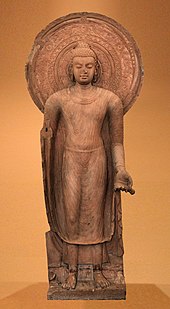
Ramagupta is known from a sixth-century play, the Devichandragupta, in which he surrenders his queen to the enemy Sakas, forcing his brother Chandragupta to sneak into the enemy camp to rescue her and kill the Saka king. The historicity of these events is unclear, but Ramagupta's existence is confirmed by three Jain statues found at Durjanpur, with inscriptions referring to him as the Maharajadhiraja. A large number of his copper coins also have been found from the Eran-Vidisha region and classified in five distinct types, which include the Garuda,[83] Garudadhvaja, lion and border legend types. The Brahmi legends on these coins are written in the early Gupta style.[84]
Chandragupta II "Vikramaditya"
[edit]According to the Gupta records, among his sons, Samudragupta nominated prince Chandragupta II, born of queen Dattadevi, as his successor. Chandragupta II, Vikramaditya (Brave as the Sun), ruled from 375 until 415. He married a Kadamba princess of Kuntala and of Naga lineage (Nāgakulotpannnā), Kuberanaga. His daughter Prabhavatigupta from this Naga queen was married to Rudrasena II, the Vakataka king of Deccan.[85] His son Kumaragupta I was married to a Kadamba princess of the Karnataka region. Chandragupta II expanded his realm westwards, defeating the Saka Western Kshatrapas of Malwa, Gujarat and Saurashtra in a campaign lasting until 409. His main opponent Rudrasimha III was defeated by 395, and he crushed the Bengal chiefdoms. This extended his control from coast to coast, established a second capital at Ujjain and was the high point of the empire.[citation needed] Kuntala inscriptions indicate rule of Chandragupta II in Kuntala country of Karnataka.[86] Hunza inscription also indicate that Chandragupta was able to rule north western Indian subcontinent and proceeded to conquer Balkh, although some scholars have also disputed the identity of the Gupta emperor.[87][88] Chalukya king Vikramaditya VI (r. 1076 – 1126 CE) mentions Chandragupta with his title and states: "Why should the glory of the Kings Vikramaditya and Nanda be a hindrance any longer? He with a loud command abolished that (era), which has the name of Saka, and made that (era) which has the Chalukya counting".[89]
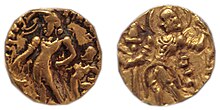
Despite the creation of the empire through war, his reign is remembered for its very influential style of Hindu art, literature, culture and science. Some excellent works of Hindu art such as the panels at the Dashavatara Temple in Deogarh serve to illustrate the magnificence of Gupta art during his reign. Above all, it was the synthesis of elements that gave Gupta art its distinctive flavour. During this period, the Guptas were supportive of thriving Buddhist and Jain cultures as well, and for this reason, there is also a long history of non-Hindu Gupta period art. In particular, Gupta period Buddhist art was to be influential in most of East and Southeast Asia. Many advances were recorded by the Chinese scholar and traveller Faxian in his diary and published afterwards.
The court of Chandragupta II was made even more illustrious by the fact that it was graced by the Navaratna (Nine Jewels), a group of nine who excelled in the literary arts. Among these men was Kālidāsa, whose works dwarfed the works of many other literary geniuses, not only in his own age but in the years to come. Kalidasa was mainly known for his subtle exploitation of the shringara (romantic) element in his verse.
Campaigns against foreign tribes
[edit]
The 4th century Sanskrit poet Kalidasa credits Chandragupta Vikramaditya with conquering about twenty-one kingdoms, both in and outside India. After finishing his campaign in East and West India, Vikramaditya (Chandragupta II) proceeded northwards, subjugated the Parasika, then the Huna and Kamboja tribes located in the west and east Oxus valleys respectively. Thereafter, the king proceeded into the Himalaya mountains to reduce the mountain tribes of the Kinnaras, Kiratas, as well as India proper.[90][non-primary source needed] In one of his works Kalidasa also credits him with the removal of the Sakas from the country. He wrote 'Wasn't it Vikramaditya who drove the Sakas out from the lovely city of Ujjain?'.[91]
The Brihatkathamanjari of the Kashmiri writer Kshemendra states, King Vikramaditya (Chandragupta II) had "unburdened the sacred earth of the barbarians like the Sakas, Mlecchas, Kambojas, Greeks, Tusharas, Saka-Greeks, Hunas, and others, by annihilating these sinful Mlecchas completely".[92][non-primary source needed][93][94][unreliable source?]
Faxian
[edit]Faxian, a Chinese Buddhist monk, was one of the pilgrims who visited India during the reign of the Gupta emperor Chandragupta II. He started his journey from China in 399 CE and reached India in 405 CE. During his stay in India up to 411 CE, he went on a pilgrimage to Mathura, Kannauj, Kapilavastu, Kushinagar, Vaishali, Pataliputra, Kashi, and Rajagriha, and made careful observations about the empire's conditions. Faxian was pleased with the mildness of administration. The penal code was mild, and offences were punished by fines only. From his accounts, the Gupta Empire was a prosperous period. His writings form one of the most important sources for the history of this period.[95]
Faxian on reaching Mathura comments––
"The snow and heat are finely tempered, and there is neither hoarfrost nor snow. The people are numerous and happy. They have not to register their households. Only those who cultivate the royal land have to pay (a portion of) the gain from it. If they want to go, they go. If they want to stay on, they stay on. The king governs without decapitation or (other) corporal punishments. Criminals are simply fined according to circumstances. Even in cases of repeated attempts at wicked rebellion, they only have their right-hand cut off. The king's bodyguards & attendants all have salaries. Throughout the whole country, the people do not kill any living creature, not drink any intoxicating liquor, nor eat onions or garlic."[95]
Kumaragupta I
[edit]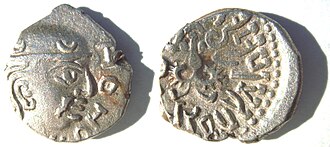
Obv: Bust of king with crescents, with traces of corrupt Greek script.[96][97]
Rev: Garuda standing facing with spread wings. Brahmi legend: Parama-bhagavata rajadhiraja Sri Kumaragupta Mahendraditya.[98]
Chandragupta II was succeeded by his second son Kumaragupta I, born of Mahadevi Dhruvasvamini. Kumaragupta I assumed the title, Mahendraditya.[99] He ruled until 455. Towards the end of his reign a tribe in the Narmada valley, the Pushyamitras, rose in power to threaten the empire. The Kidarites as well probably confronted the Gupta Empire towards the end of the rule of Kumaragupta I, as his son Skandagupta mentions in the Bhitari pillar inscription his efforts at reshaping a country in disarray, through reorganisation and military victories over the Pushyamitras and the Hunas.[100]
He was the founder of Nalanda University which on 15 July 2016 was declared as a UNESCO world heritage site.[101] Kumaragupta I was also a worshipper of Kartikeya.
Skandagupta
[edit]Skandagupta, son and successor of Kumaragupta I is generally considered to be the last of the great Gupta emperors. He assumed the titles of Vikramaditya and Kramaditya.[102] He defeated the Pushyamitra threat, but then was faced with invading Kidarites (sometimes described as the Hephthalites or "White Huns", known in India as the Sweta Huna), from the northwest.
He repelled a Huna attack around 455 CE, but the expense of the wars drained the empire's resources and contributed to its decline. The Bhitari Pillar inscription of Skandagupta, the successor of Chandragupta, recalls the near annihilation of the Gupta Empire following the attacks of the Kidarites.[103] The Kidarites seem to have retained the western part of the Gupta Empire.[103]
Skandagupta died in 467 and was succeeded by his agnate brother Purugupta.[104]
Decline of the empire
[edit]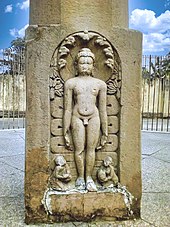
Following Skandagupta's death, the empire was clearly in decline,[106] and the later Gupta coinage indicates their loss of control over much of western India after 467–469.[17] Skandagupta was followed by Purugupta (467–473), Kumaragupta II (473–476), Budhagupta (476–495), Narasimhagupta (495–530), Kumaragupta III (530–540), Vishnugupta (540–550), two lesser known kings namely, Vainyagupta and Bhanugupta.
In the late 490's the Alchon Huns under Toramana and Mihirakula broke through the Gupta defences in the northwest, and much of the empire in the northwest was overrun by the Huns by 500. According to some scholars the empire disintegrated under the attacks of Toramana and his successor Mihirakula.[107][108] It appears from inscriptions that the Guptas, although their power was much diminished, continued to resist the Huns. The Hun invader Toramana was defeated by Bhanugupta in 510.[109][110] The Huns were defeated and driven out of India in 528 by King Yashodharman from Malwa, and possibly Gupta emperor Narasimhagupta.[111]
These invasions, although only spanning a few decades, had long term effects on India, and in a sense brought an end to Classical Indian civilisation.[112] Soon after the invasions, the Gupta Empire, already weakened by these invasions and the rise of local rulers such as Yashodharman, ended as well.[113] Following the invasions, northern India was left in disarray, with numerous smaller Indian powers emerging after the crumbling of the Guptas.[114] The Huna invasions are said to have seriously damaged India's trade with Europe and Central Asia.[112] In particular, Indo-Roman trade relations, which the Gupta Empire had greatly benefited from. The Guptas had been exporting numerous luxury products such as silk, leather goods, fur, iron products, ivory, pearl, and pepper from centres such as Nasik, Paithan, Pataliputra, and Benares. The Huna invasion probably disrupted these trade relations and the tax revenues that came with them.[citation needed]
Furthermore, Indian urban culture was left in decline, and Buddhism, gravely weakened by the destruction of monasteries and the killing of monks by the hand of the vehemently anti-Buddhist Shaivist Huna king Mihirakula, started to collapse.[112] Great centres of learning were destroyed, such as the city of Taxila, bringing cultural regression.[112] During their rule of 60 years, the Alchons are said to have altered the hierarchy of ruling families and the Indian caste system. For example, the Hunas are often said to have become the precursors of the Rajputs.[112]
The succession of the 6th-century Guptas is not entirely clear, but the tail end recognised ruler of the dynasty's main line was King Vishnugupta, reigning from 540 to 550. In addition to the Huna invasion, the factors, which contribute to the decline of the empire include competition from the Vakatakas and the rise of Yashodharman in Malwa.[116]
The last known inscription by a Gupta emperor is from the reign of Vishnugupta (the Damudarpur copper-plate inscription),[117] in which he makes a land grant in the area of Kotivarsha (Bangarh in West Bengal) in 542/543 CE.[118] This follows the occupation of most of northern and central India by the Aulikara King Yashodharman c. 532 CE.[118]
Archaeologist Shanker Sharma concluded based off a 2019 study that the cause of the Gupta Empire's downfall was a devastating flood which happened around the middle of the 6th century in Uttar Pradesh and Bihar.[citation needed]
Post-Gupta successor dynasties
[edit]In the heart of the former Gupta Empire, in the Gangetic region, the Guptas were succeeded by the Maukhari dynasty and the Pushyabhuti dynasty.[119] The coinage of the Maukharis and Pushyabhutis followed the silver coin type of the Guptas, with portrait of the ruler in profile (although facing in the reverse direction compared to the Guptas, a possible symbol of antagonism)[120] and the peacock on the reverse, the Brahmi legend being kept except for the name of the ruler.[119]
In the western regions, they were succeeded by Gurjaradesa, the Gurjara-Pratiharas, and later the Chaulukya-Paramara dynasties, who issued so-called Indo-Sasanian coinage, on the model of the coinage of the Sasanian Empire, which had been introduced in India by the Alchon Huns.[119]
Military
[edit]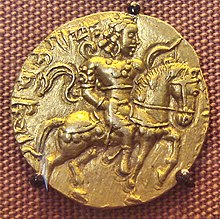
In contrast to the Mauryan Empire, the Guptas introduced several military innovations to Indian warfare. Chief among these was the use of siege engines, heavy cavalry archers and heavy sword cavalry. Heavy cavalry formed the core of the Gupta Army and were supported by the traditional Indian Army elements of war elephants and light infantry.[122]
The utilisation of horse archers in the Gupta period is evidenced on the coinage of Chandragupta II, Kumaragupta I and Prakasaditya (postulated to be Purugupta)[123] that depicts the kings as horse-archers.[124][125]
There is a paucity of contemporary sources detailing the tactical operations of the Imperial Gupta Army. The best extant information comes from the Sanskrit mahakavya (epic poem) Raghuvaṃśa written by the Classical Sanskrit writer and dramatist Kalidasa. Many modern scholars put forward the view that Kalidasa lived from the reign of Chandragupta II to the reign of Skandagupta[126][127][128][129] and that the campaigns of Raghu – his protagonist in the Raghuvaṃśa – reflect those of Chandragupta II.[130] In Canto IV of the Raghuvamsa, Kalidasa relates how the king's forces clash against the powerful, cavalry-centric, forces of the Persians and later the Yavanas (probably Huns) in the North-West. Here he makes special mention of the use horse-archers in the king's army and that the horses needed much rest after the hotly contested battles.[131] The five arms of the Gupta military included infantry, cavalry, chariotry, elephantry and ships. Gunaighar copper plate inscription of Vainya Gupta mentions ships but not chariots.[132]
Religion
[edit]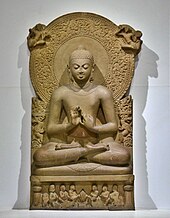
The Guptas were traditionally a Hindu dynasty.[133] They were patronizers of Brahmanism[b] and allowed followers of Buddhism and Jainism to practice their religions.[138] Sanchi remained an important centre of Buddhism.[138] Kumaragupta I (455 CE) is said to have founded Nalanda.[138] Modern genetic studies indicate that it was during the Gupta period that Indian caste groups ceased to intermarry (started practising/enforcing endogamy).[139]
Some later rulers however seem to have especially promoted Buddhism. Narasimhagupta Baladitya (c. 495–?), according to contemporary writer Paramartha, was brought up under the influence of the Mahayanist philosopher, Vasubandhu.[133] He built a sangharama at Nalanda and also a 300 ft (91 m) high vihara with a Buddha statue within which, according to Xuanzang, resembled the "great Vihara built under the Bodhi tree". According to the Manjushrimulakalpa (c. 800 CE), King Narasimhsagupta became a Buddhist monk, and left the world through meditation (Dhyana).[133] The Chinese monk Xuanzang also noted that Narasimhagupta Baladitya's son, Vajra, who commissioned a sangharama as well, "possessed a heart firm in faith".[140]: 45 [141]: 330
Administration
[edit]A study of the epigraphical records of the Gupta Empire shows that there was a hierarchy of administrative divisions from top to bottom. It was divided into 26 provinces, which were called Bhukti, Desha or Rajya. Provinces were also divided into vishayas or pradeshas (districts) and put under the control of Vishayapatis (district lords). A Vishayapati administered the Vishaya with the help of the Adhikarana (council of representatives), which comprised four representatives: Nagarasreshesthi, Sarthavaha, Prathamakulika and Prathama Kayastha. A part of the Vishaya was called Vithi.[142] The Gupta also had trading links with the Sassanid and Byzantine Empires.[citation needed] The four-fold varna system was observed under the Gupta period but caste system was fluid. Brahmins followed non-Brahmanical professions as well. Kshatriyas were involved in trade and commerce. The society largely coexisted among themselves.[143][need quotation to verify]
Urban centres
[edit]Gupta administration proved to be highly conducive for the rapid growth of urban centres. The principal and original capital of the Gupta Empire is regarded to be Prayag.[3][4][5][6] In the fifth century, the capital was moved to Ayodhya under either Kumaragupta or Skandagupta.[7][8][9][6] Chandragupta Vikramaditya took personal interest in the development of Ujjain as a major cultural center after its conquest.[144] Kāśī is sometimes considered by some scholars to have been a capital, either as the original capital,[145] the principal late 6th-century capital[7] or a minor later capital.[8] The Chinese author Faxian described Magadha as a prosperous country with rich towns and large populations.
Legacy
[edit]Mathematics
[edit]Indian mathematics flourished in the Gupta Empire.[146] The Indian numerals which were the first positional base 10 numeral systems in the world originated from Gupta India. The Surya Siddhanta contains the Sine table.[147] Aryabhata, wrote the Aryabhatiya, making significant contributions to mathematics including developing a Place value system, an approximation of π of 4 decimal places, trigonometric functions, and Squared triangular numbers.[148][149] Varāhamihira wrote the Pancha Siddhanta developing various formulas relating sine and cosine functions.[150] Yativṛṣabha made contributions on units of measurement.[151] Virahanka described Fibonacci numbers.[152][151]
Astronomy
[edit]Indian astronomy also saw progress in this era. The names of the seven days in a week appeared at the start of the Gupta period based on Hindu deities and planets corresponding to the Roman names.[153] Aryabhata made several contributions such as assigning the start of each day to midnight.[154] the earth's rotation on its axis, westward motion of the stars.[154] Aryabhata also mentioned that reflected sunlight is the cause behind the shining of the Moon.[154] In his book, Aryabhata, he suggested that the Earth was sphere, containing a circumference of 24,835 miles (39,967 km).[155] Varāhamihira approximates the method for determination of the meridian direction from any three positions of the shadow using a gnomon.[156]
Medicine
[edit]The Sushruta Samhita, which is a Sanskrit redaction text on all of the major concepts of Ayurveda medicine with innovative chapters on surgery, dates to the Gupta period.[157]
Metallurgy and Engineering
[edit]The Iron Pillar of Delhi high resistance to corrosion .[158][159] The corrosion resistance results from an even layer of crystalline iron(III) hydrogen phosphate hydrate forming on the high-phosphorus-content iron, which serves to protect it from the effects of the corrosion[158][159] The earliest evidence of the cotton gin was found in the fifth century, in the form of Buddhist paintings depicting a single-roller gin in the Ajanta Caves.[160] The gins consisted of a single roller made of iron or wood and a flat piece of stone or wood.[160]
Education
[edit]Various Mahavihara operated throughout the Gupta Empire serving as centuries of education.[161] Nalanda played a vital role in promoting the patronage of arts and academics during the 5th and 6th century CE.[162]
Literature
[edit]The highest point of Sanskrit literature is also said to have belonged to this period.[163] Harisena was an early writer of Kāvya poetry.[164] his works include Apabramsa Dharmapariksa, Karpuraprakara (Suktavall), the medical treatise Jagatsundari-Yogamaladhikara, Yasodharacanta, Astahnikakatha and Brhatkathakosa.[165] Amarasimha wrote various on Sanskrit grammar.[166] Kalidasa, a playwright, wrote plays such as the Abhijnanashakuntalam and Shakuntala.[167] Bhartṛhari published major works including the Trikāṇḍī and Śatakatraya.[168]
Leisure
[edit]Chess is said to have developed in this period.[169] Its early form in the 6th century, caturaṅga, which translates as "four divisions [of the military]" (infantry, cavalry, chariotry, and elephantry), was represented by the pieces that would evolve into the modern pawn, knight, rook, and bishop respectively. Doctors also invented several medical instruments, and even performed surgical operations. The ancient Gupta text Kama Sutra by the Indian scholar Vatsyayana is widely considered to be the standard work on human sexual behaviour in Sanskrit literature.
Art and architecture
[edit]-
A tetrastyle prostyle Gupta period temple at Sanchi besides the Apsidal hall with Maurya foundation, an example of Buddhist architecture and Hindu architecture.[170][failed verification][171][172] 5th century CE.
-
Pataini temple is a Jain temple built during the Gupta period.
The Gupta period is generally regarded as a classic peak of North Indian art for all the major religious groups. Although painting was evidently widespread, the surviving works are almost all religious sculptures. The period saw the emergence of the iconic carved stone deity in Hindu art, as well as the Buddha-figure and Jain tirthankara figures, the latter often on a very large scale. The two great centres of sculpture were Mathura and Gandhara, the latter the centre of Greco-Buddhist art. Both exported sculpture to other parts of northern India.
The most famous remaining monuments in a broadly Gupta style, the caves at Ajanta, Elephanta, and Ellora (respectively Buddhist, Hindu, and mixed including Jain) were in fact produced under later dynasties, but primarily reflect the monumentality and balance of Gupta style. Ajanta contains by far the most significant survivals of painting from this and the surrounding periods, showing a mature form which had probably had a long development, mainly in painting palaces.[173] The Hindu Udayagiri Caves actually record connections with the dynasty and its ministers,[174] and the Dashavatara Temple at Deogarh is a major temple, one of the earliest to survive, with important sculpture.[175]
-
Buddha from Sarnath, 5–6th century CE
-
The Colossal trimurti at the Elephanta Caves
-
Nalrajar Garh fortification wall in Chilapata Forests, West Bengal, is one of the last surviving fortification remains from the Gupta period, currently 5–7 m high
-
Nalanda University was first established under Gupta Empire
-
Bitargaon temple from the Gupta period provide one of the earliest examples of pointed arches anywhere in the world
-
Ajanta caves from Gupta era
-
Krishna fighting the horse demon Keshi, 5th century
Family tree and list of rulers
[edit]See also
[edit]| History of India |
|---|
 |
| Timeline |
Notes
[edit]References
[edit]- ^ Goyal, SR. History of the imperial Guptas. p. 367.
- ^ Schwartzberg, Joseph E. (1978). A Historical atlas of South Asia. Chicago: University of Chicago Press. p. 145, map XIV.1 (j); p.25. ISBN 0226742210. Archived from the original on 24 February 2021. Retrieved 12 February 2022.
- ^ a b Sharma, R. S. (2005). India's Ancient Past.
UP therefore seems to have been the place from where the Guptas operated and fanned out in different directions. Probably with their centre of power at Prayag, they spread into the neighbouring regions.
- ^ a b Chaurasia, Radhey Shyam (2002). History of Ancient India. Atlantic Publishers & Dist. p. 160. ISBN 978-81-269-0027-5.
The original kingdom of the Guptas comprised Uttar Pradesh and Bihar. The early Gupta coins and inscriptions have been mainly found in Uttar Pradesh. It seems that the Guptas found out in different directions from Uttar Pradesh. The centre of their power was Prayag.
- ^ a b Sharma, Tej Ram (1989). A Political History of the Imperial Guptas. Concept Publishing Company. p. 39. ISBN 978-81-7022-251-4.
Prayaga region of the modern eastern Uttar Pradesh was the centre of power of the early Guptas
- ^ a b c d Goyal, S. R. (1967). History Of The Imperial Guptas. pp. 210–213.
The capital of the Guptas was located somewhere in the eastern part of U. P. The evidence of the Puranas from which we learn that Prayāga was the nucleus of the original Gupta state, the incision of the prasasti of Samudragupta on a stone pillar at Prayāga, the discovery of several other early Gupta inscriptions and numerous hoards of coins from this area, and the possibility of the performance of Asvamedha at Prayāga by Samudragupta bring out the fact that at least in the early part of their history, the Guptas had their capital at Prayāga. [...] Later on, however, Ayodhyā was made the formal residence of the emperor, for, Paramartha, a Buddhist scholar of the Gupta age refers to this city as the capital of Vikramaditya i.e. Skandagupta who appointed Vasubandhu as the teacher of his crown-prince Bālāditya.
- ^ a b c Raychaudhuri, Hemchandra (2006). Political History of Ancient India. Cosmo Publications. p. 496. ISBN 978-81-307-0291-9.
The importance of this identification lies in the fact that it proves that the immediate successors of Skanda Gupta had a capital at Ayodhyā probably till the rise of the Maukharis. If the spurious Gayā plate is to be believed Ayodhyā was the seat of a Gupta jaya-skandhāvāra, or 'camp of victory,' as early as the time of Samudra Gupta. The principal capital of Bālāditya and his successors appears to have been Kāśī.
- ^ a b c Mookerji, Radhakumud (1989). The Gupta Empire. Motilal Banarsidass Publ. p. 52. ISBN 978-81-208-0089-2.
the successors of Chandra Gupta II set up their capital at Ayodhyā. It also appears from the Sarnath Stone inscription of Prakațāditya (Fleet, No. 79) that they had another capital at Kāśī.
- ^ a b Hans T. Bakker (1982). "The rise of Ayodhya as a place of pilgrimage". Indo-Iranian Journal. 24 (2): 105. doi:10.1163/000000082790081267. S2CID 161957449.
During the reign of either the emperor Kumāragupta or, more probably, that of his successor Skandagupta (AD 455–467), the capital of the empire was moved from Pāțaliputra to Ayodhyā...
- ^ Sharma, Tej Ram (1978). Personal and geographical names in the Gupta inscriptions. Robarts - University of Toronto. Delhi : Concept. p. 112.
An indication of the leaning of the Gupta kings towards Vaisnavism is clear from the Garuda emblem of the Guptas. The gupta monarchs also used the title 'Paramabhāgavata' i.e.; the devout devotee of Visnu, in their imperial records.
- ^ Bakker, Hans T. (12 March 2020). The Alkhan: A Hunnic People in South Asia. Barkhuis. p. 73. ISBN 978-94-93194-00-7.
On the south banks of the Bina, the building of a religious complex dedicated to Vishnu, the Empire's tutelary deity, had expanded under Budhagupta.
- ^ pg.17 : Gupta Empire at its height (5th-6th centuries) connected with the development of Mahayana Buddhism with the development of Tantric Buddhism.Ganeri, Anita (2007). Buddhism. Internet Archive. London : Franklin Watts. p. 17. ISBN 978-0-7496-6979-9.
- ^ Smith, Vincent A. "Chapter 11 – The Gupta Empire and the Western Satraps: Chandragupta I to Kumaragupta I". The Public's Library and Digital Archive. Retrieved 14 July 2024.
- ^ Turchin, Peter; Adams, Jonathan M.; Hall, Thomas D (December 2006). "East-West Orientation of Historical Empires". Journal of World-Systems Research. 12 (2): 223. doi:10.5195/JWSR.2006.369. ISSN 1076-156X.
- ^ Taagepera, Rein (1979). "Size and Duration of Empires: Growth-Decline Curves, 600 B.C. to 600 A.D". Social Science History. 3 (3/4): 121. doi:10.2307/1170959. JSTOR 1170959.
- ^ Angus Maddison (2001). "Growth of World Population, GDP and GDP Per Capita before 1820". p. 238.
- ^ a b "Gupta Dynasty". 29 October 2009. Archived from the original on 29 October 2009. Retrieved 30 November 2024.
The dynasty controlled an empire stretching across north India at its peak in the 5th century.
- ^ N. Jayapalan, History of India, Vol. I, (Atlantic Publishers, 2001), 130.
- ^ Jha, D.N. (2002). Ancient India in Historical Outline. Delhi: Manohar Publishers and Distributors. pp. 149–73. ISBN 978-81-7304-285-0.
- ^ Pletcher 2011, p. 90: "Historians once regarded the Gupta period (c.320–540) as the classical age of India [...] It was also thought to have been an age of material prosperity, particularly among the urban elite [...] Some of these assumptions have been questioned by more-extensive studies of the post-Mauryan, pre-Gupta period. Archaeological evidence from the earlier Kushan levels suggests greater material prosperity, to such a degree that some historians argue for an urban decline in the Gupta period."
- ^ Stein 2010, p. 86-87.
- ^ Gupta dynasty (Indian dynasty) Archived 30 March 2010 at the Wayback Machine. Britannica Online Encyclopedia. Retrieved 21 November 2011.
- ^ Keay, John (2000). India: A history. Atlantic Monthly Press. pp. 151–52. ISBN 978-0-87113-800-2.
Kalidasa wrote ... with excellence which, by unanimous consent, justifies the inevitable comparisons with Shakespeare ... When and where Kalidasa lived remains a mystery. He acknowledges no links with the Guptas; he may not even have coincided with them ... but the poet's vivid awareness of the terrain of the entire subcontinent argues strongly for a Guptan provenance.
- ^ Vidya Dhar Mahajan 1990, p. 540.
- ^ a b Keay, John (2000). India: A history. Atlantic Monthly Press. p. 132. ISBN 978-0-87113-800-2.
The great era of all that is deemed classical in Indian literature, art and science was now dawning. It was this crescendo of creativity and scholarship, as much as ... political achievements of the Guptas, which would make their age so golden.
- ^ Gupta dynasty: empire in 4th century Archived 30 March 2010 at the Wayback Machine. Britannica Online Encyclopedia. Retrieved 21 November 2011.
- ^ a b J.C. Harle 1994, p. 87.
- ^ Dikshitar, V. R. Ramachandra (1993). The Gupta Polity. Motilal Banarsidass Publ. ISBN 978-81-208-1024-2. Archived from the original on 2 August 2020. Retrieved 1 July 2020.
- ^ Nath sen, Sailendra (1999). Ancient Indian History and Civilization. Routledge. p. 227. ISBN 9788122411980. Archived from the original on 7 May 2021. Retrieved 30 August 2020.
- ^ Ashvini Agrawal 1989, pp. 264–69.
- ^ Grousset, Rene (1970). The Empire of the Steppes. Rutgers University Press. p. 69. ISBN 978-0-8135-1304-1.
- ^ Ashvini Agrawal 1989, p. 79.
- ^ Chakrabarti, K. (1996). "The Gupta Kingdom". In Guand-da, Zhang; Litvinsky, B.; Shabani Samghabadi, R. (eds.). History of Civilizations of Central Asia: The crossroads of civilizations, A.D. 250 to 750. Vol. III. UNESCO. p. 188. ISBN 978-92-3-103211-0. Retrieved 24 July 2017.
On the basis of ... historians have now come to accept the lower doab region as the original homeland of the Guptas
- ^ Dilip Kumar Ganguly 1987, p. 14.
- ^ Tej Ram Sharma 1989, p. 39.
- ^ Dilip Kumar Ganguly 1987, p. 2.
- ^ Ashvini Agrawal 1989, p. 2.
- ^ Kumar, Sanjeev (18 July 2024). Treasures of the Gupta Empire: A Numismatic History of the Golden Age of India. Archaeopress Publishing Ltd. p. 196. ISBN 978-1-80327-796-7.
- ^ Dilip Kumar Ganguly 1987, pp. 7–11.
- ^ Dilip Kumar Ganguly 1987, p. 12.
- ^ Tej Ram Sharma 1989, p. 44.
- ^ Ashvini Agrawal 1989, p. 82.
- ^ Tej Ram Sharma 1989, p. 42.
- ^ R. S. Sharma (2003). Early Medieval Indian Society: A Study in Feudalisation. Orient Longman. ISBN 9788125025238. Archived from the original on 26 March 2021. Retrieved 26 June 2019.
- ^ R.C. Majumdar 1981, p. 4.
- ^ Tej Ram Sharma 1989, p. 40.
- ^ Tej Ram Sharma 1989, pp. 43–44.
- ^ Ashvini Agrawal 1989, p. 83.
- ^ Full inscription, Fleet, John Faithfull (1888). Corpus Inscriptionum Indicarum Vol. 3. pp. 1–17.
- ^ Tej Ram Sharma 1989, pp. 49–55.
- ^ Ashvini Agrawal 1989, p. 86.
- ^ "The Gupta Empire | Boundless World History". courses.lumenlearning.com. Archived from the original on 28 December 2020. Retrieved 30 January 2021.
- ^ Ashvini Agrawal 1989, pp. 84–85.
- ^ Ashvini Agrawal 1989, pp. 79–81.
- ^ Ashvini Agrawal 1989, p. 85.
- ^ R.C. Majumdar 1981, pp. 6–7.
- ^ R.C. Majumdar 1981, p. 10.
- ^ Tej Ram Sharma 1989, p. 71.
- ^ Tej Ram Sharma 1989, pp. 51–52.
- ^ Ashvini Agrawal 1989, pp. 106–07.
- ^ Ashvini Agrawal 1989, p. 114.
- ^ Ashvini Agrawal 1989, p. 117.
- ^ Ashvini Agrawal 1989, p. 107.
- ^ a b Ashvini Agrawal 1989, p. 112.
- ^ Ashvini Agrawal 1989, p. 110.
- ^ Tej Ram Sharma 1989, pp. 80–81.
- ^ Tej Ram Sharma 1989, p. 84.
- ^ a b Upinder Singh 2017, p. 343.
- ^ Ashvini Agrawal 1989, pp. 112–18.
- ^ Ashvini Agrawal 1989, p. 125.
- ^ Shankar Goyal 2001, p. 168.
- ^ Tej Ram Sharma 1989, p. 90.
- ^ a b Tej Ram Sharma 1989, p. 68.
- ^ R.C. Majumdar 1981, p. 32.
- ^ Tej Ram Sharma 1989, p. 91.
- ^ Ashvini Agrawal 1989, pp. 125–26.
- ^ Tej Ram Sharma 1989, pp. 91, 94.
- ^ R.C. Majumdar 1981, p. 31.
- ^ Tej Ram Sharma 1989, p. 94.
- ^ R.C. Majumdar 1981, pp. 23, 27.
- ^ R.C. Majumdar 1981, p. 22.
- ^ Smith, Vincent Arthur (1911). A history of fine art in India and Ceylon, from the earliest times to the present day. Oxford: Clarendon Press. pp. 170–171.
- ^ Ashvini Agrawal 1989, pp. 153–59.
- ^ Bajpai, K.D. (2004). Indian Numismatic Studies. New Delhi: Abhinav Publications. pp. 120–21. ISBN 978-81-7017-035-8. Archived from the original on 4 May 2016. Retrieved 25 October 2015.
- ^ H.C. Raychaudhuri 1923, p. 489.
- ^ "Annual Report Of Mysore 1886 To 1903" – via Internet Archive.
- ^ "HALDEIKISH, Sacred Rocks of Hunza". Hunza Bytes. Archived from the original on 13 May 2021. Retrieved 20 October 2020.
- ^ Singh, Upinder (2008). A History of Ancient and Early Medieval India: From the Stone Age to the 12th Century. Pearson Education India. p. 480. ISBN 978-81-317-1120-0. Archived from the original on 18 March 2022. Retrieved 3 May 2021.
- ^ Barua, Benimadhab (1929). Old Brahmi Inscriptions In The Udayagiri And Khandagiri Caves.
- ^ Raghu Vamsa v 4.60–75
- ^ Wolpert, Stanley (1993). India. Oxford University Press.
- ^ ata shrivikramadityo helya nirjitakhilah Mlechchana Kamboja. Yavanan neechan Hunan Sabarbran Tushara. Parsikaanshcha tayakatacharan vishrankhalan hatya bhrubhangamatreyanah bhuvo bharamavarayate (Brahata Katha, 10/1/285-86, Kshmendra).
- ^ Kathasritsagara 18.1.76–78
- ^ Cf:"In the story contained in Kathasarit-sagara, king Vikarmaditya is said to have destroyed all the barbarous tribes such as the Kambojas, Yavanas, Hunas, Tokharas and the, National Council of Teachers of English Committee on Recreational Reading – Sanskrit language.
- ^ a b Fa-hsien (1886). A record of Buddhistic kingdoms; being an account by the Chinese monk Fâ-Hien of his travels in India and Ceylon, A.D. 399–414, in search of the Buddhist books of discipline. Translated and annotated with a Corean recension of the Chinese text. Translated by Legge, James. Oxford Clarendon Press.
- ^ Prasanna Rao Bandela (2003). Coin splendour: a journey into the past. Abhinav Publications. pp. 112–. ISBN 978-81-7017-427-1. Archived from the original on 29 May 2013. Retrieved 21 November 2011.
- ^ "Evidence of the conquest of Saurastra during the reign of Chandragupta II is to be seen in his rare silver coins which are more directly imitated from those of the Western Satraps... they retain some traces of the old inscriptions in Greek characters, while on the reverse, they substitute the Gupta type (a peacock) for the chaitya with crescent and star." in Rapson "A catalogue of Indian coins in the British Museum. The Andhras etc...", p. cli
- ^ Virji, krishnakumari J. (1952). Ancient History Of Saurashtra. p. 225.
- ^ Ashvini Agrawal 1989, pp. 191–200.
- ^ Chakrabarti, K. (1996). "The Gupta Kingdom". In Guand-da, Zhang; Litvinsky, B.; Shabani Samghabadi, R. (eds.). History of Civilizations of Central Asia: The crossroads of civilizations, A.D. 250 to 750. Vol. III. UNESCO. p. 191. ISBN 978-92-3-103211-0.
- ^ "Nalanda University Ruins | Nalanda Travel Guide | Ancient Nalanda Site". Travel News India. 5 October 2016. Archived from the original on 11 February 2017. Retrieved 20 February 2017.
- ^ H.C. Raychaudhuri 1923, p. 510.
- ^ a b The Huns, Hyun Jin Kim, Routledge, 2015 pp. 50–
- ^ H.C. Raychaudhuri 1923, p. 516.
- ^ Sharma, Tej Ram (1978). Personal and Geographic Names in Gupta Inscriptions (PDF). p. 93.
- ^ Sachchidananda Bhattacharya, Gupta dynasty, A dictionary of Indian history, (George Braziller, Inc., 1967), 393.
- ^ "The Alchon Huns....established themselves as overlords of northwestern India, and directly contributed to the downfall of the Guptas" in Neelis, Jason (2010). Early Buddhist Transmission and Trade Networks: Mobility and Exchange Within and Beyond the Northwestern Borderlands of India. BRILL. p. 162. ISBN 9789004181595. Archived from the original on 3 January 2022. Retrieved 20 May 2019.
- ^ Bakker, Hans (2017), Monuments of Hope, Gloom and Glory in the Age of the Hunnic Wars: 50 years that changed India (484–534), Royal Netherlands Academy of Arts and Sciences, Section 4, ISBN 978-90-6984-715-3, archived from the original on 11 January 2020, retrieved 20 May 2019
- ^ Ancient Indian History and Civilization by Sailendra Nath Sen p. 220
- ^ Encyclopaedia of Indian Events & Dates by S B. Bhattacherje p. A15
- ^ Columbia Encyclopedia
- ^ a b c d e The First Spring: The Golden Age of India by Abraham Eraly pp. 48– Archived 5 January 2020 at the Wayback Machine
- ^ Ancient Indian History and Civilization by Sailendra Nath Sen p. 221
- ^ A Comprehensive History Of Ancient India p. 174
- ^ Schwartzberg, Joseph E. (1978). A Historical atlas of South Asia. Chicago: University of Chicago Press. pp. 26, 146. ISBN 0226742210. Archived from the original on 6 February 2022. Retrieved 18 April 2022.
- ^ Singh, Upinder (2008). A History of Ancient and Early Medieval India: From the Stone Age to the 12th Century. New Delhi: Pearson Education. p. 480. ISBN 978-81-317-1677-9. Archived from the original on 20 December 2016. Retrieved 25 October 2015.
- ^ Corpus Inscriptionum Indicarum Vol.3 (inscriptions of the Early Gupta emperors) p. 362
- ^ a b Indian Esoteric Buddhism: Social History of the Tantric Movement by Ronald M. Davidson p. 31 Archived 7 January 2020 at the Wayback Machine
- ^ a b c Ray, Himanshu Prabha (2019). Negotiating Cultural Identity: Landscapes in Early Medieval South Asian History. Taylor & Francis. pp. 161–164. ISBN 9781000227932. Archived from the original on 20 May 2022. Retrieved 27 September 2022.
- ^ Tripathi, Rama S. (1989). History of Kanauj: To the Moslem Conquest. Motilal Banarsidass Publ. p. 45 Note 1. ISBN 9788120804043. Archived from the original on 17 April 2022. Retrieved 27 September 2022.
- ^ *1910,0403.26
- ^ Roy, Kaushik (2015). Warfare in Pre-British India, 1500 BCE to 1740 CE. Routledge. p. 56. ISBN 978-1-315-74270-0. Archived from the original on 9 July 2021. Retrieved 8 August 2020.
- ^ Ganguly, Dilip Kumar (1987). The Imperial Guptas and Their Times. Abhinav Publications. p. 92. ISBN 9788170172222. Archived from the original on 14 August 2020. Retrieved 29 August 2018.
- ^ Roy, Kaushik (2015). Warfare in Pre-British India, 1500 BCE to 1740 CE. Routledge. p. 57. ISBN 978-1-315-74270-0. Archived from the original on 9 July 2021. Retrieved 8 August 2020.
- ^ Majumdar, Bimal Kanti (1960). The military system in ancient India (2 ed.). Firma K.L. Mukhopadhyay. p. 118.
- ^ Vasudev Vishnu Mirashi and Narayan Raghunath Navlekar (1969). Kālidāsa; Date, Life, and Works. Popular Prakashan. pp. 1–35. ISBN 9788171544684.
- ^ Ram Gopal. p.14
- ^ C. R. Devadhar (1999). Works of Kālidāsa. Vol. 1. Motilal Banarsidass. pp. vii–viii. ISBN 9788120800236.
- ^ Gaurīnātha Śāstrī (1987). A Concise History of Classical Sanskrit Literature. Motilal Banarsidass. pp. 77–78. ISBN 978-81-208-0027-4.
- ^ Roy, Kaushik (2015). Warfare in Pre-British India, 1500 BCE to 1740 CE. Routledge. p. 58. ISBN 978-1-315-74270-0. Archived from the original on 9 July 2021. Retrieved 8 August 2020.
- ^ Kale, Moreshwar Ramchandra (1922). The Raghuvamsa of Kalidasa. Canto IV: P.S. Rege.
- ^ Bimal Kanti Majumdar (1949). "Military Pursuits and National Defence Under the Second Magadhan Empire". Proceedings of the Indian History Congress. 12: 105–109. JSTOR 44140516.
- ^ a b c A History of Ancient and Early Medieval India by Upinder Singh p. 521
- ^ St-pierre, Paul (2007). In Translation - Reflections, Refractions, Transformations. John Benjamins Publishing Company. p. 159.
- ^ Wangu, Madhu Bazaz (2003). Images of Indian Goddesses. Abhinav Publications. p. 97.
- ^ O'Brien-Kop, Karen (2021). Rethinking 'Classical Yoga' and Buddhism. Bloomsbury Publishing. p. 151.
- ^ Bala, Poonam (2007). Medicine and Medical Policies in India. Lexington Books. p. 37.
- ^ a b c The Gupta Empire by Radhakumud Mookerji pp. 133– Archived 17 December 2019 at the Wayback Machine
- ^ Newitz, Annalee (25 January 2016). "The caste system has left its mark on Indians' genomes". Ars Technica. Archived from the original on 8 June 2021. Retrieved 8 June 2021.
- ^ Sankalia, Hasmukhlal Dhirajlal (1934). The University of Nālandā. B.G. Paul & co. ISBN 9781014542144. Archived from the original on 10 March 2017. Retrieved 27 July 2017.
- ^ Sukumar Dutt (1988) [First published in 1962]. Buddhist Monks And Monasteries of India: Their History And Contribution To Indian Culture. George Allen and Unwin Ltd, London. ISBN 978-81-208-0498-2. Archived from the original on 10 March 2017. Retrieved 27 July 2017.
- ^ Vidya Dhar Mahajan 1990, pp. 530–31.
- ^ Nath sen, Sailendra (1999). Ancient Indian History and Civilization. Routledge. p. 235. ISBN 9788122411980. Archived from the original on 27 September 2022. Retrieved 21 September 2020.
- ^ Dandekar, R. N. (1960). "Some Aspects of the Gupta Civilization: Economic Conditions". Bulletin of the Deccan College Research Institute. 20 (1/4): 108–115. ISSN 0045-9801. JSTOR 42929739.
- ^ Kumar, Sanjeev (18 July 2024). Treasures of the Gupta Empire: A Numismatic History of the Golden Age of India (2nd ed.). Archaeopress Publishing Ltd. p. 196. ISBN 978-1-80327-796-7.
In the Allahabad Pillar Inscription, line 28, Śrīgupta is referred to as "the prosperous Mahārāja Śrīgupta." As a minor ruler of a small territory primarily centered around Kāśī (present day Vārāņasī), it is possible that he would have issued only coins in silver for local consumption.
- ^ Yau, Shing-Tung (2013). "The Past, Present and Future of Mathematics in China and India". Notices of the International Congress of Chinese Mathematicians. 1 (2): 95–108. doi:10.4310/iccm.2013.v1.n2.a11. ISSN 2326-4810.
- ^ Deva Shastri, Pundit Bapu (1861). Translation of the Surya Siddhanta. pp. 15–16.
- ^ George. Ifrah (1998). A Universal History of Numbers: From Prehistory to the Invention of the Computer. London: John Wiley & Sons.
- ^ Boyer, Carl B. (1991). "The Mathematics of the Hindus". A History of Mathematics (Second ed.). John Wiley & Sons, Inc. p. 207. ISBN 0-471-54397-7.
He gave more elegant rules for the sum of the squares and cubes of an initial segment of the positive integers. The sixth part of the product of three quantities consisting of the number of terms, the number of terms plus one, and twice the number of terms plus one is the sum of the squares. The square of the sum of the series is the sum of the cubes.
- ^ A.M. Shastri 1991, p. 4.
- ^ a b Ikeyama, Setsuro (2007), "Yativṛṣabha", in Hockey, Thomas; Trimble, Virginia; Williams, Thomas R.; Bracher, Katherine (eds.), The Biographical Encyclopedia of Astronomers, New York, NY: Springer, p. 1251, doi:10.1007/978-0-387-30400-7_1513, ISBN 978-0-387-30400-7, retrieved 5 May 2021
- ^ Singh, Parmanand (1985). "The so-called fibonacci numbers in ancient and medieval India". Historia Mathematica. 12 (3): 229–244. doi:10.1016/0315-0860(85)90021-7.
- ^ Roshen Dalal (2010). Hinduism: An Alphabetical Guide. Penguin Books. p. 89. ISBN 978-0-14-341421-6.
- ^ a b c Hayashi (2008), Aryabhata I
- ^ Indian Astronomy. (2013). In D. Leverington, Encyclopedia of the history of Astronomy and Astrophysics. Cambridge, United Kingdom: Cambridge University Press. Retrieved from http://search.credoreference.com/content/entry/cupaaa/indian_astronomy/0
- ^ Abraham (2008)
- ^ Champaneria, Manish C.; Workman, Adrienne D.; Gupta, Subhas C. (July 2014). "Sushruta: Father of Plastic Surgery". Annals of Plastic Surgery. 73 (1): 2–7. doi:10.1097/SAP.0b013e31827ae9f5. PMID 23788147.
- ^ a b On the Corrosion Resistance of the Delhi Iron Pillar, R. Balasubramaniam, Corrosion Science, Volume 42 (2000) pp. 2103 to 2129. Corrosion Science is a publication specialized in corrosion science and engineering.
- ^ a b Yoshio Waseda; Shigeru Suzuki (2006). Characterization of corrosion products on steel surfaces. Springer. p. vii. ISBN 978-3-540-35177-1.
- ^ a b Lakwete, 1–6.
- ^ Buddhist Monks And Monasteries Of India: Their History And Contribution To Indian Culture. by Dutt, Sukumar. George Allen and Unwin Ltd, London 1962. pg 352-3
- ^ Ingalls, Daniel H. H. (1976). "Kālidāsa and the Attitudes of the Golden Age". Journal of the American Oriental Society. 96 (1): 15–26. doi:10.2307/599886. ISSN 0003-0279. JSTOR 599886.
- ^ Chandra Rajan (2005). The Loom Of Time. Penguin UK. pp. 268–274. ISBN 9789351180104.
- ^ Keith, Arthur Berriedale (1966). A History of Sanskrit literature. Oxford University Press. pp. 76–7.
- ^ Sharma, Tej Ram (1989). A Political History of the Imperial Guptas: From Gupta to Skandagupta. Concept Publishing Company. p. 90. ISBN 978-81-7022-251-4.
- ^ Amarakosha compiled by B. L. Rice, edited by N. Balasubramanya, 1970, page X
- ^ Kālidāsa (2001). The Recognition of Sakuntala: A Play In Seven Acts. Oxford University Press. pp. ix. ISBN 9780191606090. Archived from the original on 22 October 2020. Retrieved 14 January 2016.
- ^ Cornille, Catherine (8 June 2020). The Wiley-Blackwell Companion to Inter-Religious Dialogue. John Wiley & Sons. p. 199. ISBN 978-1-119-57259-6.
- ^ Murray, H.J.R. (1913). A History of Chess. Benjamin Press (originally published by Oxford University Press). ISBN 978-0-936317-01-4. OCLC 13472872.
- ^ Harle, 111;
- ^ Rowland 1967, pp. 219–220.
- ^ Michell 1988, p. 94.
- ^ J.C. Harle 1994, pp. 118–22, 123–26, 129–35.
- ^ J.C. Harle 1994, pp. 92–97.
- ^ J.C. Harle 1994, pp. 113–14.
Bibliography
[edit]- Ashvini Agrawal (1989). Rise and Fall of the Imperial Guptas. Motilal Banarsidass. ISBN 978-81-208-0592-7. Archived from the original on 8 January 2020. Retrieved 29 August 2018.
- Dilip Kumar Ganguly (1987). The Imperial Guptas and Their Times. Abhinav. ISBN 978-81-7017-222-2. Archived from the original on 8 January 2020. Retrieved 29 August 2018.
- H.C. Raychaudhuri (1923). Political History of Ancient India: From the Accession of Parikshit to the Extinction of the Gupta Dynasty. University of Calcutta. ISBN 978-1-4400-5272-9.
- J.C. Harle (1994). The Art and Architecture of the Indian Subcontinent. Yale University Press. ISBN 978-0-300-06217-5.
- R.C. Majumdar (1981). A Comprehensive History of India. Vol. 3, Part I: A.D. 300-985. Indian History Congress / People's Publishing House. pp. 17–52. OCLC 34008529.
- Michell, George (1988) [First published 1977]. The Hindu Temple: An Introduction to its Meaning and Forms. University of Chicago Press. ISBN 978-0-226-53230-1.
- Pletcher, Kenneth (2011). The History of India. Britannica Educational Publishing. ISBN 978-1-61530-201-7.
- Rowland, Benjamin (1967) [First published 1953]. The Art and Architecture of India: Buddhist, Hindu, Jain (3rd ed.). Penguin Books. ISBN 978-0-14-056102-9.
- Shankar Goyal (2001). Problems of Ancient Indian History: New Perspectives and Perceptions. Book Enclave. ISBN 978-81-87036-66-1. Archived from the original on 11 January 2020. Retrieved 13 December 2018.
- A.M. Shastri (1991). Varāhamihira and His Times. Kusumanjali. OCLC 28644897.
- Tej Ram Sharma (1989). A Political History of the Imperial Guptas: From Gupta to Skandagupta. Concept. ISBN 978-81-7022-251-4. Archived from the original on 13 January 2020. Retrieved 29 August 2018.
- Vidya Dhar Mahajan (1990). A History of India. State Mutual Book & Periodical Service. ISBN 978-0-7855-1191-5. Archived from the original on 10 January 2020. Retrieved 29 August 2018.
- Upinder Singh (2017). Political Violence in Ancient India. Harvard University Press. ISBN 978-0-674-98128-7. Archived from the original on 10 January 2020. Retrieved 13 December 2018.
- Stein, B. (2010), Arnold, D. (ed.), A History of India (2nd ed.), Oxford: Wiley-Blackwell, ISBN 978-1-4051-9509-6
External links
[edit] Media related to Gupta Empire at Wikimedia Commons
Media related to Gupta Empire at Wikimedia Commons- Coins of Gupta Empire
- Gupta Empire
- 3rd-century establishments in India
- 570s disestablishments
- 6th-century disestablishments in India
- Dynasties of India
- Hindu states
- States and territories established in the 240s
- States and territories disestablished in the 570s
- History of Uttar Pradesh
- History of India
- Prayagraj
- Ayodhya
- 3rd-century establishments
- 6th-century disestablishments






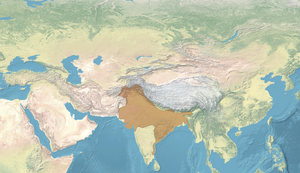
![A tetrastyle prostyle Gupta period temple at Sanchi besides the Apsidal hall with Maurya foundation, an example of Buddhist architecture and Hindu architecture.[170][failed verification][171][172] 5th century CE.](http://upload.wikimedia.org/wikipedia/commons/thumb/1/1f/Sanchi_temple_17.jpg/480px-Sanchi_temple_17.jpg)

